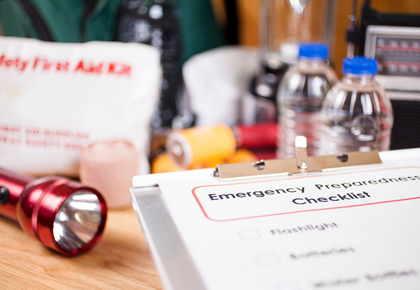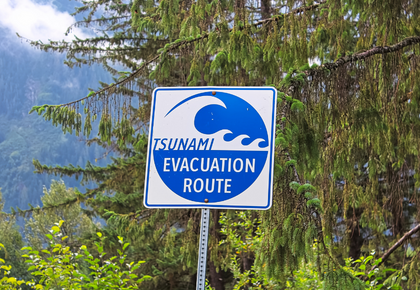Earthquakes & Tsunamis: What to Do and How to Stay Safe
If you live in British Columbia, you know that earthquakes are a common occurrence with an average of 3000 reported each year. While most are too small to be felt, one strong enough to cause structural damage occur about once a decade. Additionally, tsunamis are another possibility for BC, especially for those communities located near the coast. While more severe earthquakes and tsunamis may be less common, it’s the unpredictability that makes them scary and why it’s important everyone do their best to be prepared.

“Of course, you can’t prevent earthquakes or tsunamis, but you can make sure your community is as prepared and ready as possible,” said Chris Churchill, president of FirstService Residential BC. "Should the next earthquake be more severe than usual, there are things you can do for your community to minimize potential injury and damage and get through it as safely as possible."
If you’re a member of your strata corporation’s council, you’ll want to take additional measures to protect your residents and property as well. One of the most important things you can do is make sure your residents are informed about the risks of dangerous earthquakes and tsunamis and how to respond.
Ways to keep emergency preparedness top of mind for your residents include providing emergency response information on a regular basis, perhaps within a quarterly newsletter. For more in-depth information, you can prepare a handbook that is updated on an annual or as needed basis and provided to residents and/or housed in easy to find places.
If your strata corporation is partnered with a quality property management company, you can rely on them to assist with immediate communications to residents during an emergency using a system that can send texts, emails, and phone calls. Let’s take a look at some of the things you, as a council member, should be communicating to residents about what they should do to prepare for severe weather.
1. Understand Earthquake and Tsunami Basics
British Columbia is a seismically active province, with the most at-risk regions being along the west coast. It’s those same regions where the threat of a tsunami is also very real. Earthquakes are caused by the movement of tectonic plates on the earth’s surface whether they are moving apart, sliding past each other or colliding.
While earthquakes can’t be predicted, tsunamis often can be. The areas that can be impacted by a tsunami in BC are divided into five zones, Greater Vancouver area being part of zone e. It’s important to know your zone as it will help you determine if your community is under a warning, advisory or watch issued by the National Tsunami Warning Center.
2. Know the Signs
The signs of an earthquake are not something you see but are something you can hear and feel. Typically, the first sign of an earthquake is a loud bang or roar. You may then feel the ground shake and roll for several minutes. Aftershocks, or smaller earthquakes can continue for hours or even days after the initial quake.
While earthquakes cannot be foreseen, tsunamis can be. Should a powerful earthquake take place, a tsunami may follow. If it happens far enough away it can take hours for the waves to hit the coastline, however if it happens near land, the waves can appear within minutes. The Tsunami Warning System, an international program will alert Emergency Management BC should they believe a tsunami is expected.
3. Create a Plan for What to Do and Where to Go
In BC it’s not a question of if you will experience an earthquake, the question is how severe will the earthquake be. This is why it makes good sense to prepare in advance so you’re ready to react quickly if you ever need to.
When you feel the ground shake, you should immediately, drop, cover, and hold on. Dropping to your hands and knees prevents you from falling but allows you to move if necessary. If you’re indoors, stay indoors and cover your head and neck with you arm and take shelter under a sturdy piece of furniture. Hold on to the furniture until the shaking stops and remain there for 60 seconds after. If you are somewhere without a sturdy piece of furniture, crawl to the nearest interior corner or wall, staying away from windows.

In the event of a tsunami, if you live in one of the tsunami zones, prepare by getting to know your local evacuation routes and receptions centre locations. In areas that don’t have evacuation plans, practice routes that will take you at least 20 metres above sea level.

Practice earthquake and tsunami drills with your family so they know what to do. Make sure everyone knows how to shut off the power, water and gas – and just in case, knows the location of the family first aid kit. Keep fire extinguishers handy and teach everyone in your home how to use them. You’ll also want to have fresh batteries and a battery-powered TV or radio on hand to stay informed if the power goes out.
Having a communication plan is an important part to being prepared for an earthquake or tsunami. You should have a list of people you can contact for help, one contact should live far away and one should live nearby. Along with a communication plan you should have set emergency meeting points, one close to home and another outside of your neighbourhood.
4. Keep Important Papers Close by and Duplicated Elsewhere
Keep a list of important information close by, including your insurance agent, property manager and/or landlord. In addition, compile your insurance policy numbers and important information about your family’s medical conditions and prescriptions, vehicles, and bank account numbers. You may also want to document how to access radio and TV stations that may broadcast important emergency storm information. Make sure important documents like birth certificates, SIN cards, insurance policies, wills, and documentation of your home’s contents (lists and photographs) are stored in a water- and fire-proof safe or a safety deposit box at your bank, or both. It’s also a good idea to have all this information scanned and backed up to an offsite or cloud storage service.
5. Take Shelter the Right Way
-
If you're at home during an earthquake, remember to drop, cover and hold on
-
You may also want to cover each family member's body with a blanket, sleeping bag or mattress to prevent injury from flying glass or debris.
-
If you're in your car, pull over to a safe place where you’re not blocking the road, stop the car and stay inside. Listen to your car radio for instructions from emergency officials.
-
If you're outdoors on foot, move away from buildings and utility wires. Ideally you want to find an open area away from trees.
These tips are a good start to help you prepare for the worst. For more valuable earthquake and tsunami safety information and guidelines, check out the helpful resources below:
PreparedBC
ShakeOut BC
Tsunami Warning Center
Canadian Red Cross